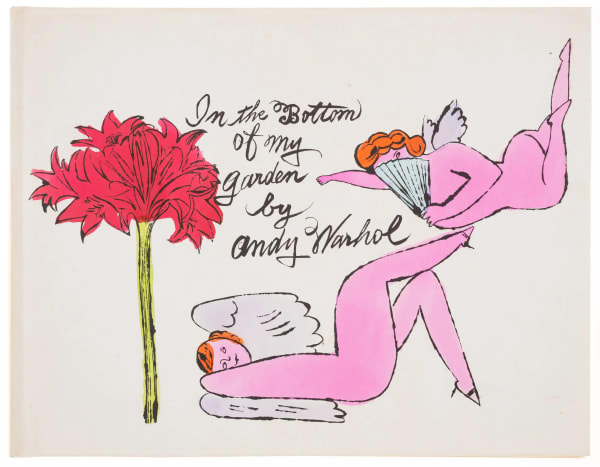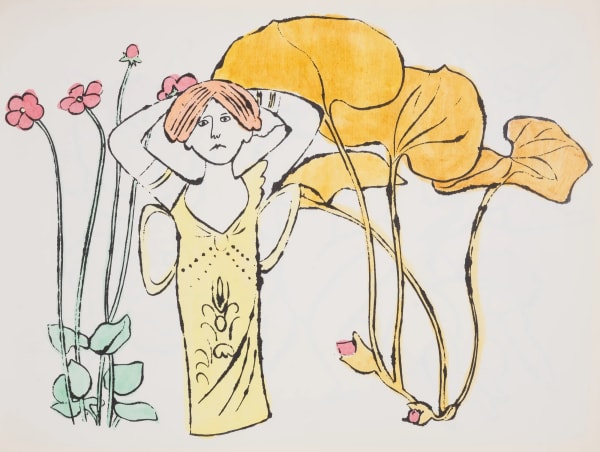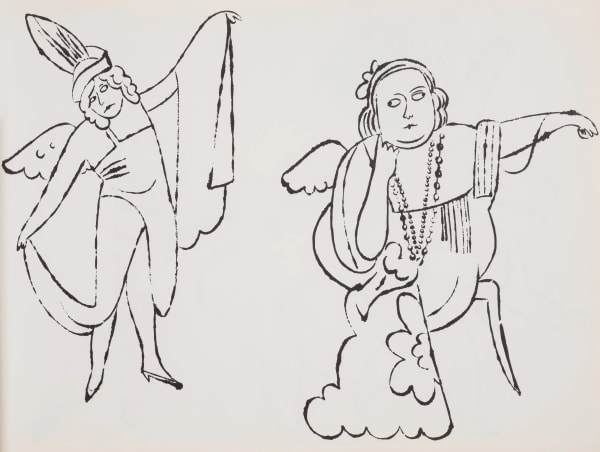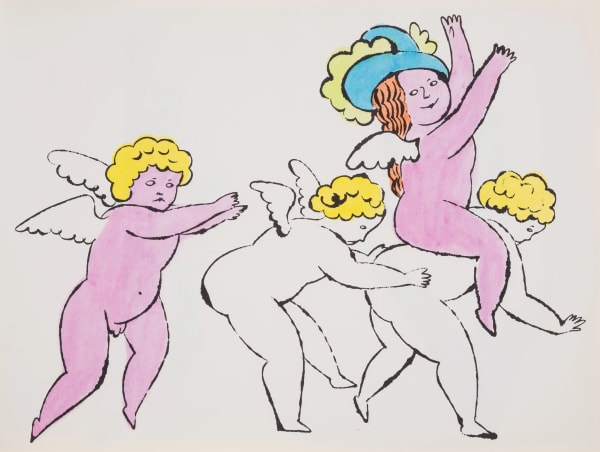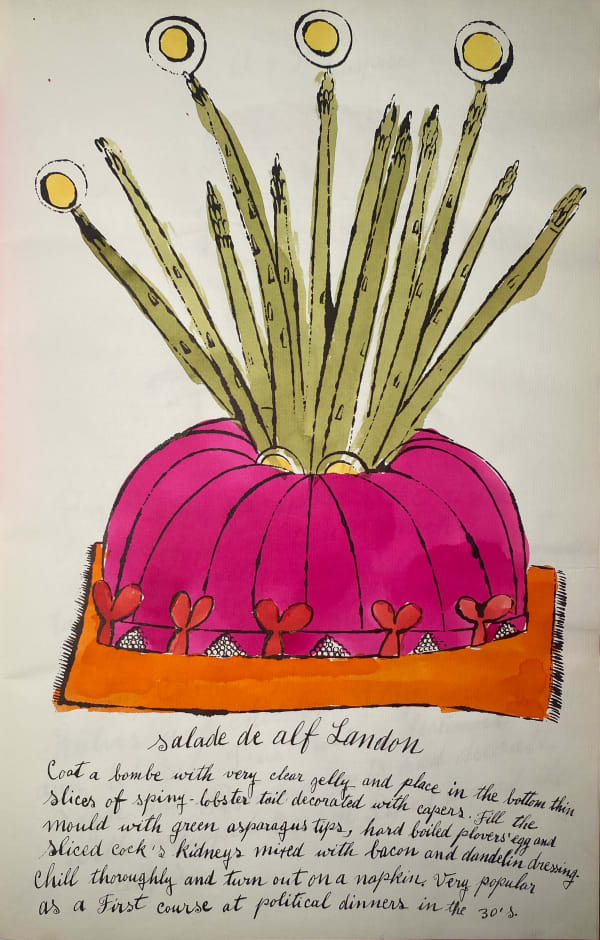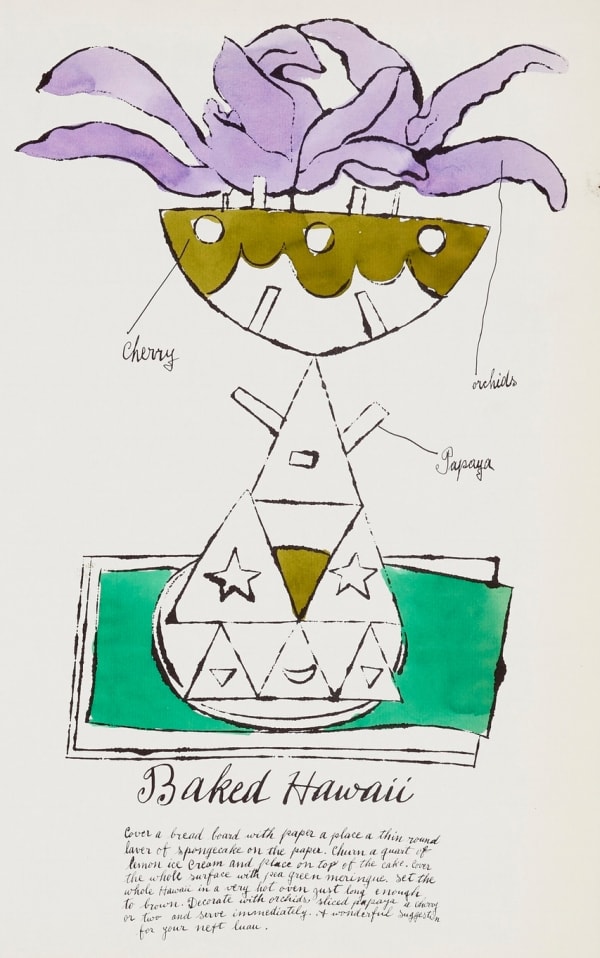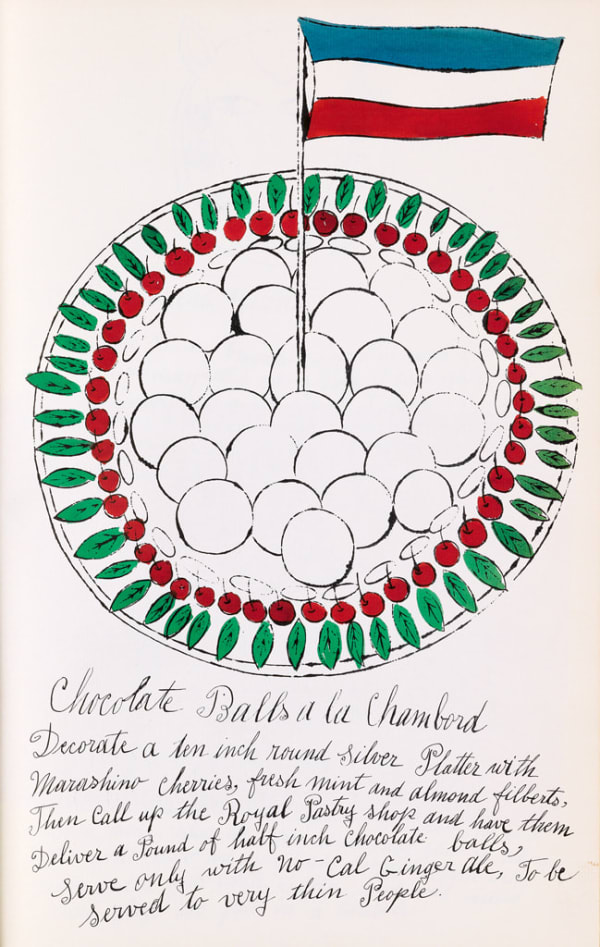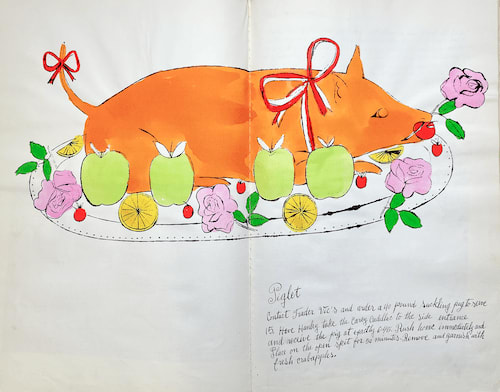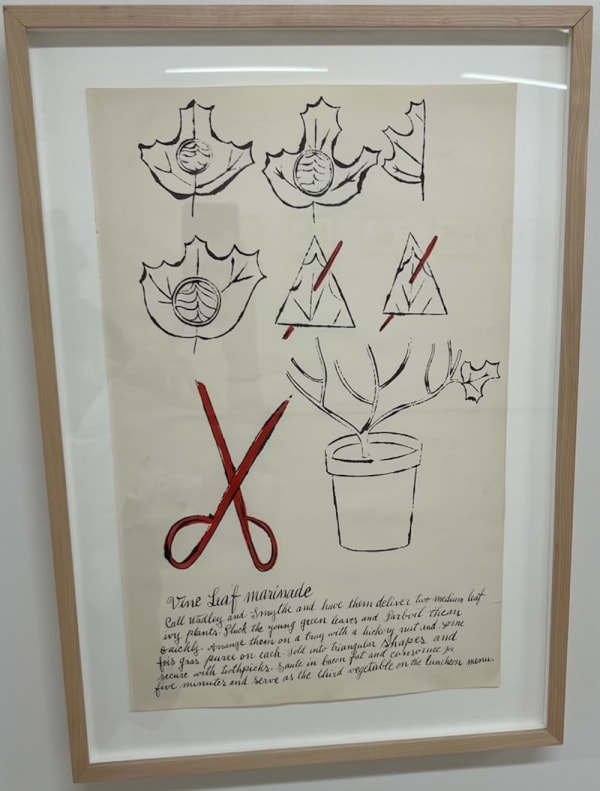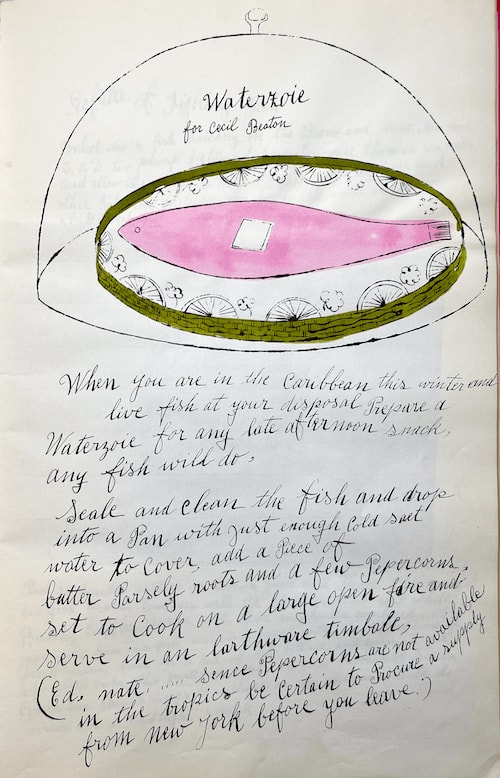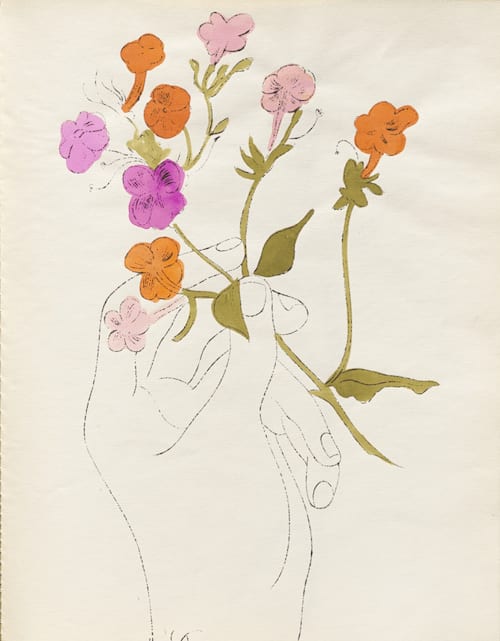Andy Warhol Watercolors and Illustrations from the 1950s
The graphic art Andy Warhol produced during the 1950s exudes a distinct expressiveness, characterized by a delicate sensibility and subtle references to sexuality. These works reveal a more personal side of Warhol, contrasting sharply with the detached persona associated with his later Pop Art. During this period, Warhol was determined to establish himself as a “fine artist,” seeking creative freedom beyond the constraints imposed by art directors. However, his whimsical creations, rooted in print-production techniques, struggled to gain traction in a cultural landscape dominated by Abstract Expressionism. It was only when he reimagined these works—melding iconic imagery from popular culture, such as Marilyn Monroe and soup cans, with silkscreen techniques—that he defined his signature Pop Art style. Despite this transformation, Warhol’s pre-Pop creations, featuring figures like Alice B. Toklas and Oscar Wilde, garnered a loyal following. Though less technically complex than his later prints, these early works were equally original and served as a vital step in the evolution of his printing methods.
Between 1953 and 1959, Warhol self-published a series of portfolios, books, and individual prints. These works, created as offset lithographs, were typically printed in a single color on white paper, with some hand-colored elements, and produced in varying edition sizes. Except for one instance, Warhol relied heavily on his distinctive blotted-line technique, a method he developed during his time at the Carnegie Institute of Technology. In the realm of graphic reproduction, these drawings served as the "line art," representing the initial step in the reproduction process.
Explore original Andy Warhol art at Guy Hepner and contact info@guyhepner.com for latest availabilities or speak to our team to sell your Andy Warhol prints.
-
 Andy WarholIn The Bottom Of My Garden (Cover), 1956
Andy WarholIn The Bottom Of My Garden (Cover), 1956 -
 Andy WarholF.S. IV86A In The Bottom Of My Garden, 1956
Andy WarholF.S. IV86A In The Bottom Of My Garden, 1956 -
 Andy WarholF.S. IV87A In The Bottom Of My Garden , 1956
Andy WarholF.S. IV87A In The Bottom Of My Garden , 1956 -
 Andy WarholF.S. IV88A In The Bottom Of My Garden, 1956
Andy WarholF.S. IV88A In The Bottom Of My Garden, 1956 -
 Andy WarholF.S. IV89A In The Bottom Of My Garden, 1956
Andy WarholF.S. IV89A In The Bottom Of My Garden, 1956 -
 Andy WarholF.S. IV90A In The Bottom Of My Garden, 1956
Andy WarholF.S. IV90A In The Bottom Of My Garden, 1956 -
 Andy WarholF.S. IV91A In The Bottom Of My Garden, 1956
Andy WarholF.S. IV91A In The Bottom Of My Garden, 1956 -
 Andy WarholF.S. IV92A In The Bottom Of My Garden, 1956
Andy WarholF.S. IV92A In The Bottom Of My Garden, 1956 -
 Andy WarholF.S. IV93A In The Bottom Of My Garden, 1956
Andy WarholF.S. IV93A In The Bottom Of My Garden, 1956 -
 Andy WarholF.S. IV105A In The Bottom Of My Garden, 1956
Andy WarholF.S. IV105A In The Bottom Of My Garden, 1956 -
 Andy WarholF.S. IV94A In The Bottom Of My Garden, 1956
Andy WarholF.S. IV94A In The Bottom Of My Garden, 1956 -
 Andy WarholF.S. IV95A In The Bottom Of My Garden, 1956
Andy WarholF.S. IV95A In The Bottom Of My Garden, 1956 -
 Andy WarholF.S. IV96A In The Bottom Of My Garden, 1956
Andy WarholF.S. IV96A In The Bottom Of My Garden, 1956 -
 Andy WarholF.S. IV98A In The Bottom Of My Garden, 1956
Andy WarholF.S. IV98A In The Bottom Of My Garden, 1956 -
 Andy WarholF.S. IV99A In The Bottom Of My Garden, 1956
Andy WarholF.S. IV99A In The Bottom Of My Garden, 1956 -
 Andy WarholF.S. IV97A In The Bottom Of My Garden , 1956
Andy WarholF.S. IV97A In The Bottom Of My Garden , 1956 -
 Andy WarholF.S. IV104A In The Bottom Of My Garden, 1956
Andy WarholF.S. IV104A In The Bottom Of My Garden, 1956 -
 Andy WarholF.S. IV103A In The Bottom Of My Garden, 1956
Andy WarholF.S. IV103A In The Bottom Of My Garden, 1956 -
 Andy WarholF.S. IV102A In The Bottom Of My Garden, 1956
Andy WarholF.S. IV102A In The Bottom Of My Garden, 1956 -
 Andy WarholF.S. IV101A In The Bottom Of My Garden, 1956
Andy WarholF.S. IV101A In The Bottom Of My Garden, 1956 -
 Andy WarholF.S. IV100A In The Bottom Of My Garden, 1956
Andy WarholF.S. IV100A In The Bottom Of My Garden, 1956 -
 Andy WarholA + P . Surprise F.S. IV 127A, from Wild Raspberries, 1959
Andy WarholA + P . Surprise F.S. IV 127A, from Wild Raspberries, 1959 -
 Andy WarholBaked Hawaii F.S. IV 126A, from Wild Raspberries, 1959
Andy WarholBaked Hawaii F.S. IV 126A, from Wild Raspberries, 1959 -
 Andy WarholBaked Hawaii F.S. IV 137A, from Wild Raspberries, 1959
Andy WarholBaked Hawaii F.S. IV 137A, from Wild Raspberries, 1959 -
 Andy WarholChocolate Balls A La Chambord F.S. IV 128A, from Wild Raspberries, 1959
Andy WarholChocolate Balls A La Chambord F.S. IV 128A, from Wild Raspberries, 1959 -
 Andy WarholDorothy Killgallens Gateau Of Marzipan F.S. IV 139A, from Wild Raspberries, 1959
Andy WarholDorothy Killgallens Gateau Of Marzipan F.S. IV 139A, from Wild Raspberries, 1959 -
 Andy WarholGardoons A La Mousseline F.S. IV 140A, from Wild Raspberries, 1959
Andy WarholGardoons A La Mousseline F.S. IV 140A, from Wild Raspberries, 1959 -
 Andy WarholGreengauges a la Warhol F.S. IV 143A, from Wild Raspberries, 1959
Andy WarholGreengauges a la Warhol F.S. IV 143A, from Wild Raspberries, 1959 -
 Andy WarholHard Boiled Eggs F.S. IV 138A, from Wild Raspberries, 1959
Andy WarholHard Boiled Eggs F.S. IV 138A, from Wild Raspberries, 1959 -
 Andy WarholOmelet Greta Garbo F.S. IV 133A, from Wild Raspberries, 1959
Andy WarholOmelet Greta Garbo F.S. IV 133A, from Wild Raspberries, 1959 -
 Andy WarholPiglet F.S. IV 134A, from Wild Raspberries, 1959
Andy WarholPiglet F.S. IV 134A, from Wild Raspberries, 1959 -
 Andy WarholRoast Iguana Adulusion F.S. IV 136A, from Wild Raspberries, 1959
Andy WarholRoast Iguana Adulusion F.S. IV 136A, from Wild Raspberries, 1959 -
 Andy WarholSheep's Trotter Poulette, Stuffed Morels, Gullis Of Hazel Hen F.S. IV 142A, from Wild Raspberries, 1959
Andy WarholSheep's Trotter Poulette, Stuffed Morels, Gullis Of Hazel Hen F.S. IV 142A, from Wild Raspberries, 1959 -
 Andy WarholTorte A La Dobosch F.S. IV 130A, from Wild Raspberries , 1959
Andy WarholTorte A La Dobosch F.S. IV 130A, from Wild Raspberries , 1959 -
 Andy WarholVine Leaf Marinade F.S. IV 141A, from Wild Raspberries, 1959
Andy WarholVine Leaf Marinade F.S. IV 141A, from Wild Raspberries, 1959 -
 Andy WarholWaterzoie F.S. IV 131A, from Wild Raspberries, 1959
Andy WarholWaterzoie F.S. IV 131A, from Wild Raspberries, 1959 -
 Andy WarholA Gold Book , F.S. IV 108, 1957
Andy WarholA Gold Book , F.S. IV 108, 1957 -
 Andy WarholA Gold Book , F.S. IV 114, 1957
Andy WarholA Gold Book , F.S. IV 114, 1957 -
 Andy WarholA Gold Book , F.S. IV 121, 1957
Andy WarholA Gold Book , F.S. IV 121, 1957


